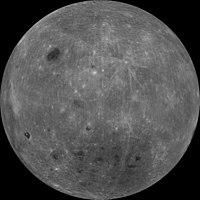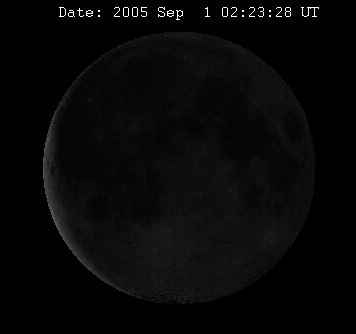Two sides of the Moon
The Moon is in synchronous rotation, which means it rotates about its axis in about the same time it takes to orbit the Earth. This results in it keeping nearly the same face turned towards the Earth at all times. The Moon used to rotate at a faster rate, but early in its history, its rotation slowed and became locked in this orientation as a result of frictional effects associated with tidal deformations caused by the Earth.[12]
Small variations (libration) in the angle from which the Moon is seen allow about 59% of its surface to be seen from the Earth (but only half at any instant).[4]
 |  | |
| Near side of the Moon | Far side of the Moon |
The side of the Moon that faces Earth is called the near side, and the opposite side the far side. The far side is often inaccurately called the "dark side," but in fact, it is illuminated exactly as often as the near side: once per lunar day, during the new Moon phase we observe on Earth when the near side is dark. The far side of the Moon was first photographed by the Soviet probe Luna 3 in 1959. One distinguishing feature of the far side is its almost complete lack of maria.

Maria
The dark and relatively featureless lunar plains which can clearly be seen with the naked eye are called maria (singular mare), Latin for seas, since they were believed by ancient astronomers to be filled with water. These are now known to be vast solidified pools of ancient basaltic lava. The majority of these lavas erupted or flowed into the depressions associated with impact basins that formed by the collisions of meteors and comets with the lunar surface. (Oceanus Procellarum is a major exception in that it does not correspond to a known impact basin). Maria are found almost exclusively on the near side of the Moon, with the far side having only a few scattered patches covering about 2% of its surface,[13] compared with about 31% on the near side.[4] The most likely explanation for this difference is related to a higher concentration of heat-producing elements on the near-side hemisphere, as has been demonstrated by geochemical maps obtained from the Lunar Prospector gamma-ray spectrometer.[14][15] Several provinces containing shield volcanoes and volcanic domes are found within the near side maria.[16]
Terrae
The lighter-colored regions of the Moon are called terrae, or more commonly just highlands, since they are higher than most maria. Several prominent mountain ranges on the near side are found along the periphery of the giant impact basins, many of which have been filled by mare basalt. These are hypothesized to be the surviving remnants of the impact basin's outer rims.[17] In contrast to the Earth, no major lunar mountains are believed to have formed as a result of tectonic events.[18]
From images taken by the Clementine mission in 1994, it appears that four mountainous regions on the rim of the 73 km-wide Peary crater at the Moon's north pole remain illuminated for the entire lunar day. These peaks of eternal light are possible because of the Moon's extremely small axial tilt to the ecliptic plane. No similar regions of eternal light were found at the south pole, although the rim of Shackleton crater is illuminated for about 80% of the lunar day. Other consequences of the Moon's small axial tilt are regions that remain in permanent shadow at the bottoms of many polar craters.[19]
Impact craters

The surface of Earth's Moon is marked by impact craters[20] which form when asteroids and comets collide with the lunar surface. There are about half a million craters with diameters greater than 1 km on the Moon.[citation needed] Since impact craters accumulate at a nearly constant rate, the number of craters per unit area superposed on a geologic unit can be used to estimate the age of the surface (see crater counting). The lack of an atmosphere, weather and recent geological processes ensures that many of these craters have remained relatively well preserved in comparison to those on Earth.
The largest crater on the Moon, which also has the distinction of being one of the largest known craters in the Solar System,[21] is the South Pole-Aitken basin. It is on the far side, between the South Pole and equator, and is some 2,240 km in diameter and 13 km in depth.[22] Prominent impact basins on the near side include Imbrium, Serenitatis, Crisium, and Nectaris.
Regolith
Blanketed atop the Moon's crust is a highly comminuted (broken into ever smaller particles) and "impact gardened" surface layer called regolith. Since the regolith forms by impact processes, the regolith of older surfaces is generally thicker than for younger surfaces. In particular, it has been estimated that the regolith varies in thickness from about 3–5 m in the maria, and by about 10–20 m in the highlands.[23] Beneath the finely comminuted regolith layer is what is generally referred to as the megaregolith. This layer is much thicker (on the order of tens of kilometres) and comprises highly fractured bedrock.[24]
Astronauts have reported that the dust from the surface felt like snow and smelled like spent gunpowder.[25] The dust is mostly made of silicon dioxide glass (SiO2), most likely created from the meteors that have crashed into the Moon's surface. It also contains calcium and magnesium.
Presence of water
The continuous bombardment of the Moon by comets and meteoroids has most likely added small amounts of water to the lunar surface. If so, sunlight would split much of this water into its constituent elements of hydrogen and oxygen, both of which would ordinarily escape into space over time, because of the Moon's weak gravity. However, because of the slightness of the axial tilt of the Moon's spin axis to the ecliptic plane—only 1.5°—some deep craters near the poles never receive direct light from the Sun and are thus in permanent shadow (see Shackleton crater). Water molecules that ended up in these craters could be stable for long periods of time.
Clementine has mapped craters at the lunar south pole[26] that are shadowed in this way, and computer simulations suggest that up to 14,000 km² might be in permanent shadow.[19] Results from the Clementine mission bistatic radar experiment are consistent with small, frozen pockets of water close to the surface, and data from the Lunar Prospector neutron spectrometer indicate that anomalously high concentrations of hydrogen are present in the upper metre of the regolith near the polar regions.[27] Estimate for the quantity of water on the Moon is 32 ounces per one ton of top layer of Moon's surface.
Water ice can be mined and then split into its constituent hydrogen and oxygen atoms by means of nuclear generators or electric power stations equipped with solar panels. The presence of usable quantities of water on the Moon is an important factor in rendering lunar habitation cost-effective, since transporting water from Earth would be prohibitively expensive. However, recent observations made with the Arecibo planetary radar suggest that some of the near-polar Clementine radar data that were previously interpreted as being indicative of water ice might instead be a result of rocks ejected from young impact craters.[28] The question of how much water there is on the Moon has not been resolved.
In July 2008, small amounts of water were found in the interior of volcanic pearls from the Moon (brought to Earth in 1971 by the Apollo 15 astronauts).[29][30]
On September 24, 2009, the Indian Space Research Organisation (ISRO) reported that their first lunar mission, Chandrayaan-1 using NASA's Moon Mineralogy Mapper, found evidence of large quantities of water on the Moon's surface, and that water is still presently being formed.[31][32] The instrument observed an absorption line in the spectrum of sunlight reflected from the Moon, indicating that light of a particular wavelength (around 2.8 microns) is being absorbed more readily than other nearby wavelengths. The position and shape of the line indicate the absorption is due to water. A nearby line also revealed the presence of the closely-related molecule hydroxyl, which consists of an oxygen atom with a single hydrogen atom. The exact abundance of water was not determined, but the team believed it could be as high as 1,000 parts per million in the top layer of Lunar soil.
On November 13, 2009, NASA announced the results of the Lunar Crater Observation and Sensing Satellite, saying that "not just water, but lots of water" had been found by the mission near the southern pole.
No comments:
Post a Comment